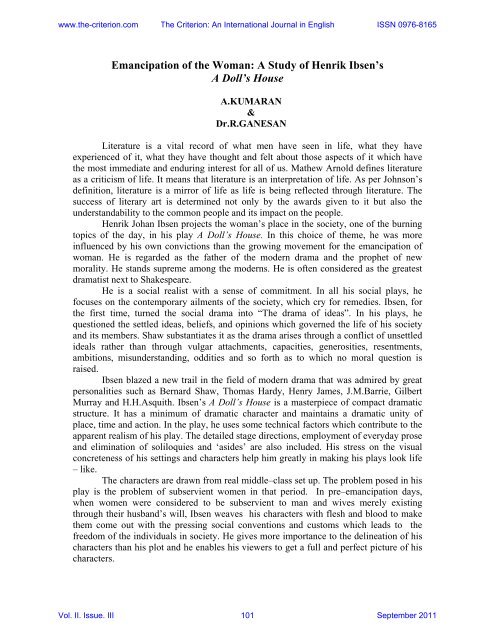Vol. II. Issue. III September 2011 - The Criterion: An International ...
Vol. II. Issue. III September 2011 - The Criterion: An International ...
Vol. II. Issue. III September 2011 - The Criterion: An International ...
You also want an ePaper? Increase the reach of your titles
YUMPU automatically turns print PDFs into web optimized ePapers that Google loves.
www.the-criterion.com <strong>The</strong> <strong>Criterion</strong>: <strong>An</strong> <strong>International</strong> Journal in English ISSN 0976-8165<br />
Emancipation of the Woman: A Study of Henrik Ibsen’s<br />
A Doll’s House<br />
A.KUMARAN<br />
&<br />
Dr.R.GANESAN<br />
Literature is a vital record of what men have seen in life, what they have<br />
experienced of it, what they have thought and felt about those aspects of it which have<br />
the most immediate and enduring interest for all of us. Mathew Arnold defines literature<br />
as a criticism of life. It means that literature is an interpretation of life. As per Johnson’s<br />
definition, literature is a mirror of life as life is being reflected through literature. <strong>The</strong><br />
success of literary art is determined not only by the awards given to it but also the<br />
understandability to the common people and its impact on the people.<br />
Henrik Johan Ibsen projects the woman’s place in the society, one of the burning<br />
topics of the day, in his play A Doll’s House. In this choice of theme, he was more<br />
influenced by his own convictions than the growing movement for the emancipation of<br />
woman. He is regarded as the father of the modern drama and the prophet of new<br />
morality. He stands supreme among the moderns. He is often considered as the greatest<br />
dramatist next to Shakespeare.<br />
He is a social realist with a sense of commitment. In all his social plays, he<br />
focuses on the contemporary ailments of the society, which cry for remedies. Ibsen, for<br />
the first time, turned the social drama into “<strong>The</strong> drama of ideas”. In his plays, he<br />
questioned the settled ideas, beliefs, and opinions which governed the life of his society<br />
and its members. Shaw substantiates it as the drama arises through a conflict of unsettled<br />
ideals rather than through vulgar attachments, capacities, generosities, resentments,<br />
ambitions, misunderstanding, oddities and so forth as to which no moral question is<br />
raised.<br />
Ibsen blazed a new trail in the field of modern drama that was admired by great<br />
personalities such as Bernard Shaw, Thomas Hardy, Henry James, J.M.Barrie, Gilbert<br />
Murray and H.H.Asquith. Ibsen’s A Doll’s House is a masterpiece of compact dramatic<br />
structure. It has a minimum of dramatic character and maintains a dramatic unity of<br />
place, time and action. In the play, he uses some technical factors which contribute to the<br />
apparent realism of his play. <strong>The</strong> detailed stage directions, employment of everyday prose<br />
and elimination of soliloquies and ‘asides’ are also included. His stress on the visual<br />
concreteness of his settings and characters help him greatly in making his plays look life<br />
– like.<br />
<strong>The</strong> characters are drawn from real middle–class set up. <strong>The</strong> problem posed in his<br />
play is the problem of subservient women in that period. In pre–emancipation days,<br />
when women were considered to be subservient to man and wives merely existing<br />
through their husband’s will, Ibsen weaves his characters with flesh and blood to make<br />
them come out with the pressing social conventions and customs which leads to the<br />
freedom of the individuals in society. He gives more importance to the delineation of his<br />
characters than his plot and he enables his viewers to get a full and perfect picture of his<br />
characters.<br />
<strong>Vol</strong>. <strong>II</strong>. <strong>Issue</strong>. <strong>II</strong>I 101 <strong>September</strong> <strong>2011</strong>
















